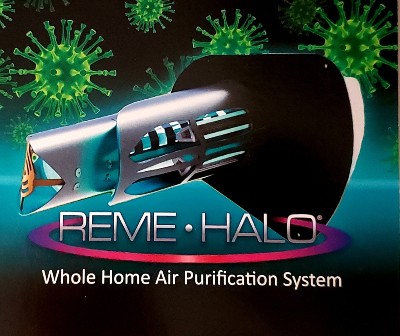Cleaner air, so you can breath easy.

Invisible germs, meet REME® Air Purifier
This is an advanced weapon against indoor viruses, allergens, and bacteria. We install it directly into your home’s ductwork converting your air system into a germ-killing machine.
- UVC light eliminates 99% of germs, bacteria, and mold spores on contact.
- Reduces odors, allergens, dust, pet dander and smoke, to help you breathe easier.
- You’ll have hospital-grade sanitized air throughout your entire home.
- The tech is patented, proven, and 100% safe.
- No expensive filters or chemicals are needed.
- Product details are on the manufacturer’s website.
Air quality experts
We have a variety of Indoor Air Quality solutions. We can sample and analyze your indoor environment, locate areas of concern, and make offer solutions to make your home a comfortable, clean, and healthy living space.
Possible solutions include:
- Air purifiers – Air purifiers continuously filter out pollutants, allergens, and pathogens. Added to almost any HVAC system, an air purifier is highly effective at destroying airborne allergens. Helping to reduce pet dander and odors, mold spores, and harmful smoke particles, and ultra-filtering dust, a central air purifying system will let you breathe with confidence.
- Ventilators – State-of-the-art ventilating systems quietly exhaust stale air with fresh outside air, using the outgoing air to temperature condition the fresh incoming air. This improves efficiency and reduces the humidity from the air before it enters your home.
- UV Lamps – Ultraviolet UV-C light is nature’s disinfectant. It penetrates the membranes of microorganisms and renders them harmless. Installed in your central air system, the UV germicidal fixtures boost your system efficiency by extending blower life and maintaining healthier indoor air quality. Hospitals use this UC lamp tech for nearly a century to sanitize the breathing air.
- Humidifiers – A whole-house humidifier adds moisture to the air, prevents static, dry skin, and sore throats, and protects your wooden surfaces. Since humidified air feels warmer, you will feel comfortable at lower thermostat settings and you save money. Also, a whole-home humidifier is more effective and simpler to maintain than portable alternatives.

Free estimate to improve the indoor air quality of your home: (361) 800-2465
There are 3 basic styles of humidifiers:
– Steam humidifiers are the most effective. A central air steam humidifier electrically heats the water until it boils, then blows the steam throughout the home vents, delivering natural and pure humidity.
– Bypass humidifiers suck your home air from your return air ducts and pass it through a water panel. The air absorbs moisture and is redistributed back into your home. Bypass humidifiers can be installed on either the supply or return plenum of a forced air handling system.
– Fan-powered humidifiers work the same way as bypass humidifiers but deliver high output with improved moisture dispersal because a fan forces air across the internal water panel.
・CO Alarms – A carbon monoxide alarm will protect your family from dangerous levels of CO in your home. Since carbon monoxide is odorless, invisible, and tasteless, it is commonly called “the silent killer”. The only way to detect the presence of carbon monoxide is with a CO alarm.
Watch the video:
U.S. Consumer Products Safety Commission:
“In the last several years, a growing body of scientific evidence has indicated that the air within homes and other buildings can be more seriously polluted than the outdoor air in even the largest and most industrialized cities.
Other research indicates that people spend approximately 90 percent of their time indoors. Thus, for many people, the risks to health may be greater due to exposure to air pollution indoors than outdoors. An air purifier might be the perfect solution.
Environmental Protection Agency (EPA):
“Mold may begin growing indoors when mold spores land on surfaces that are wet. There are many types of mold, and none of them will grow without water or moisture. Molds produce allergens (substances that can cause allergic reactions), irritants, and in some cases, potentially toxic substances (mycotoxins). Inhaling or touching mold or mold spores may cause allergic reactions in sensitive individuals.
Allergic responses include hay fever-type symptoms, such as sneezing, headaches, runny nose, red eyes, skin rash (dermatitis), asthma, and sinusitis.”
Occupation Health and Health Administration (OSHA):
“Poor indoor air quality (IAQ) has been tied to symptoms like headaches, fatigue, trouble concentrating, and irritation of the eyes, nose, throat, and lungs. Also, some diseases have been linked to air contaminants or indoor environments, like asthma with damp indoor environments.”
Children, the elderly, and those who are medically compromised, especially those suffering from respiratory or cardiovascular disease, are the most vulnerable to the effects of poor indoor air quality.